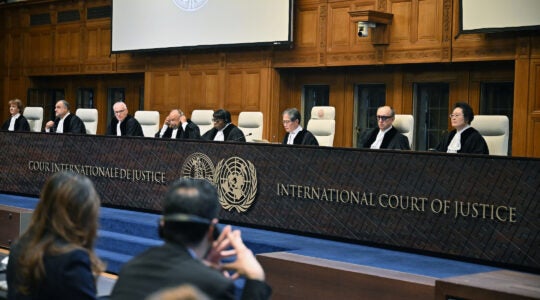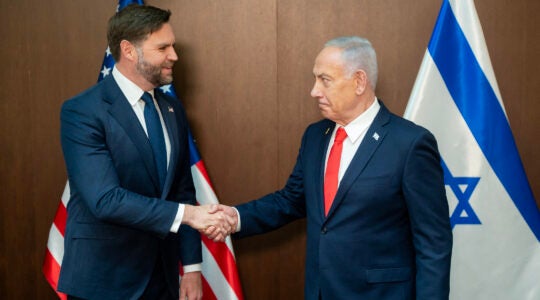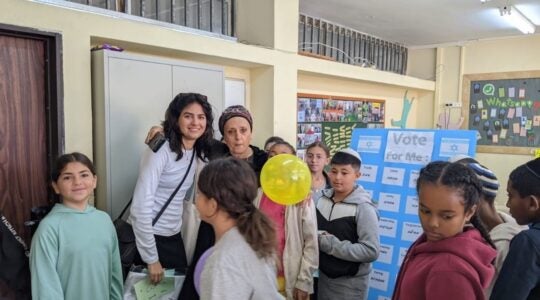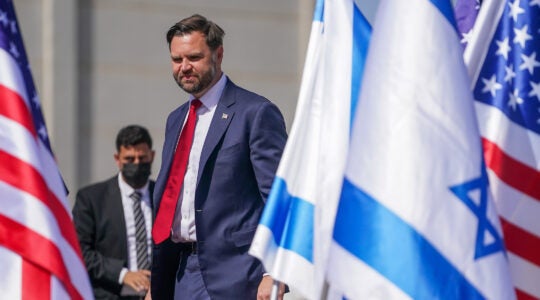NEW YORK (JTA) – When Ariel Sharon pulled Israel’s troops and settlers out of the Gaza Strip in August 2005, he was emulating a model that had worked in southern Lebanon and that he hoped would solve Israel’s Gaza problem.
For years Israel had paid a heavy cost in manpower, money and lives with its presence in Gaza, and Sharon hoped that ending the occupation would take Israeli soldiers and settlers out of the line of fire and give Israel the moral legitimacy it needed from the international community to respond to any cross-border attacks.
That essentially was what had happened along the Lebanon border after then-prime minister Ehud Barak pulled Israeli troops out in 2000, ending Israel’s 18-year occupation of southern Lebanon.
But as Israel learned during its 34-day war with Hezbollah in Lebanon in the summer of 2006, withdrawal was no guarantor of peace.
Rather than going away, the Gaza problem simply has shifted course over the past two and a half years.
Instead of aiming their guns at Gaza’s Jewish settlers and soldiers, Palestinian militants in the strip now aim their rockets – including Iranian-manufactured Katyushas smuggled in through the Gaza-Egypt border – at Jewish towns and cities in southern Israel.
This week, those rockets reached Ashkelon, a major port city of some 120,000 people.
The first significant challenge to the withdrawal strategy came just a few months after Israel’s pullout when Hamas defeated the ruling Fatah party in Palestinian legislative elections in January 2006.
Hamas militants heralded Israel’s withdrawal from Gaza as a retreat under Hamas fire, and their rhetoric of victory combined with widespread Palestinian resentment of Fatah corruption propelled Hamas legislators into office. The post of Palestinian Authority prime minister went to Hamas leader Ismail Haniyeh.
At the time, some Israelis expressed hope that the Hamas victory actually would bring progress on the peace track, since as a governing party Hamas would be forced to deal with Israel.
But Hamas’ refusal to talk to recognize Israel or halt the growing rocket attacks from Gaza signaled otherwise. A boycott of Hamas by Israel, the United States and the European Union did not bring Hamas any closer to accommodation.
On the contrary, the violence out of Gaza intensified, with ever-greater Palestinian rocket fire on Israeli towns like Sderot and the deadly attack on an Israeli army patrol in June 2006 that led to the capture of an Israeli soldier, Cpl. Gilad Shalit.
Israel responded by bombing power stations in Gaza and launching airstrikes in the strip, but to no avail: The rocket attacks continued and Shalit remained behind enemy lines.
While the war in Gaza simmered, Israel’s border with Lebanon exploded when two more Israeli soldiers, reservists Ehud Goldwasser and Eldad Regev, were taken captive in a similar cross-border attack by Hezbollah in Lebanon just two weeks after the Gaza raid.
Israel sent fighter planes into Lebanon, and Hezbollah, like Hamas in Gaza, responded by firing rockets into Israel. With a more lethal arsenal of weapons than Hamas, Hezbollah’s attacks exacted a heavier price. Thousands of Katyusha rockets landed in northern Israel, hundreds of thousands of Israelis moved to bomb shelters as cities like Haifa, Kiryat Shmona and Tiberias came under attack, and Israel was forced to send ground troops deep into Lebanese territory.
When the Second Lebanon War finally ended with a U.N.-brokered cease-fire, more than 4,000 Katyusha rockets had landed in northern Israel, some 160 Israelis had been killed, including 43 civilians, and Israel’s deterrent power had suffered a significant blow.
Although much of southern Lebanon was in tatters, an estimated 250 to 600 Hezbollah fighters were reported killed and most of Hezbollah’s rocket arsenal was destroyed, across the Arab world the war was hailed as a victory for Hezbollah and a sign that Israel could be defeated.
In Gaza, Hamas cheered Israel’s inability to deal Hezbollah a mortal blow. Encouraged by the Israel Defense Forces’ inability to halt Hezbollah’s Katyusha rocket fire, Gaza militants stepped up their own attacks on Israel with Kassams – homemade rockets fashioned from scrap metal and lampposts.
Crude though they were, the rockets continued to terrorize southern Israel. Many Israelis fled Sderot, the closest sizable Israeli town to Gaza, and those who remained lived in fear for their lives.
Things only worsened after Hamas wrested control of Gaza in June 2007 from the Fatah faction of P.A. President Mahmoud Abbas. Hamas militants ran their Fatah rivals out of town, and though Abbas deposed Haniyeh and installed his own prime minister, Salam Fayyad, Gaza remained fully under Hamas control.
Israel and the international community took advantage of the Hamas-Fatah split by re-engaging Abbas and the Palestinian Authority. International aid again began flowing to the Palestinian Authority, this time in the hope of bolstering Abbas’ relatively moderate Fatah faction, which was willing to deal with Israel, over Hamas.
The United States, determined to make a last push to seal an Israeli-Palestinian peace deal during President Bush’s tenure, announced it would host a comprehensive peace summit in November 2007 in Annapolis, Md.
As the United States tried to get its ducks in a row ahead of the conference, tensions rose between Israel and the Palestinians in Gaza. With no end in sight to the daily rocket attacks from Gaza, Israeli officials began talking about the need to invade the crowded coastal strip to stop Hamas rocket crews.
But Israeli Prime Minister Ehud Olmert was not eager for a repeat of the 2006 experience in Lebanon, where scores of Israelis died in a war that had no clear exit strategy and resulted in little tangible progress.
Instead of launching the major ground assault some opposition politicians were calling for, Olmert tightened Israel’s blockade of the strip in an attempt to drain Hamas’ strength and its support from Palestinians.
The November summit in Annapolis came and went with little more than an agreement by Olmert and Abbas to renew negotiations and push for a comprehensive peace deal by 2009. Meanwhile, in Gaza, Hamas scuttled Israel’s blockade in January by breaking down the border wall separating Gaza from Egypt and stepping up its rocket attacks on Israel.
Lask week, when Hamas rocket crews in Gaza fired Iranian-made Katyusha rockets into the Israeli city of Ashkelon, a city of 120,000, the urgency of the Gaza problem became only more apparent.
JTA has documented Jewish history in real-time for over a century. Keep our journalism strong by joining us in supporting independent, award-winning reporting.





